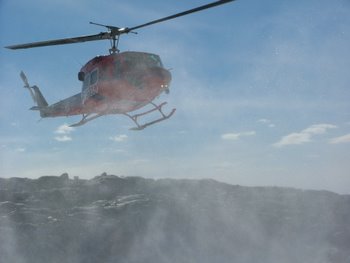After multiple weather delays, we've finally made it back to CTAM. We had fantastic weather when we woke up at Mt. Hope, but when John called CTAM, their weather was too bad for flying. For the next several hours, we called on the hour for weather updates. Finally, around 11:00 a.m., they announced that the helicopter pilots were willing to try and come get us. (They were willing to try because we'd already been out there for an extra week and CTAM knew our weather was likely to take a turn for the worse again.)
 Our 'rescue' helicopter landing to pick us up from our camp on Mt. Hope. The haze is loose, powdery snow being kicked up by the rotors.
Our 'rescue' helicopter landing to pick us up from our camp on Mt. Hope. The haze is loose, powdery snow being kicked up by the rotors.
The helicopter flight was rather hairy. Because we are wearing flight helmets that are wired in, we can hear all the discussions going on between the pilot, the helicopter technician, CTAM flight communications, and other pilots elsewhere in the region. There were some touch and go moments where we thought we might have to return to Mt. Hope. Conversations went something like this:
"Well, I can see that saddle between those peaks, but I have no idea what is on the other side." "I'm just looking for something I can recognize" Call to another pilot: "What are the clouds like over your way? Could we detour to where you are and then have enough fuel to get back to CTAM?"
 Low clouds over the Transantarctic Mountain range. We flew in through the pass on the left.
Low clouds over the Transantarctic Mountain range. We flew in through the pass on the left.
So, I kept reminding myself that people fly helicopters all the time in Antarctica and it's perfectly safe. We did have to detour some distance to the south, but had no problems returning to CTAM. Once we got back to CTAM, their weather had cleared, and it was beautiful. It was fortunate they came to get us, because the next day, Mt. Hope was again in fog.
It was so nice to be back to a place where I could be "consistently" warm. At CTAM, there's a galley that is heated with Kuma stoves which are powered by a blend of jet fuel specific to Antarctic temperatures. There's also tables and chairs and all of our meals are cooked for us. The food, by the way, is fantastic! The first night we were here, we had roasted lamb shanks, and the next day we had roast duck! It's a little closer to "civilization", which after almost four weeks of camping in the field, it feels wonderful.

